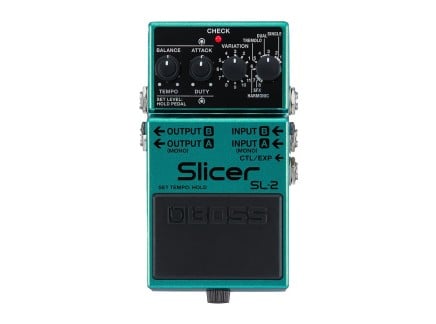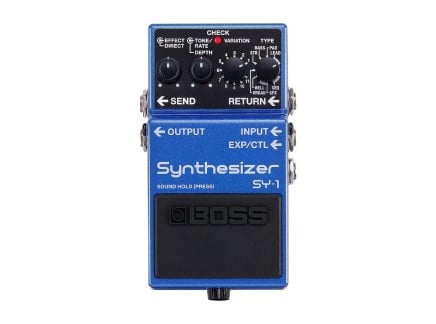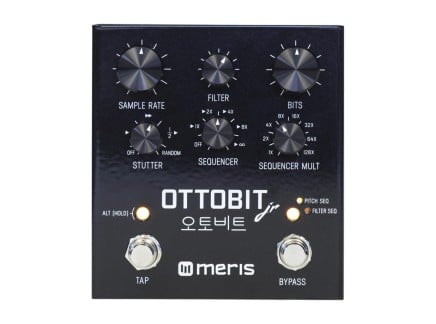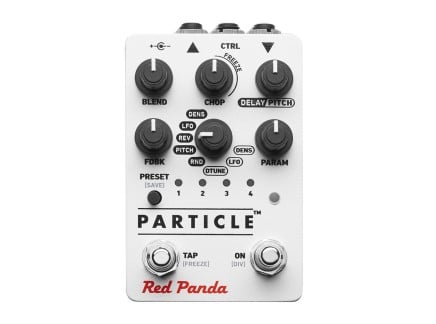At the end of last year, we teamed up with Nick Reinhart for a fun and spontaneous video, using an SP-404 and a bunch of pedals to embark on a strange but highly enjoyable sonic journey. It took a bit of time, but we had such a blast that we've invited Reinhart back to our studio for another round of fun.
We kept things open-ended, but encouraged Nick to bring along something new to our latest filming session, with the hopes of once again giving us incredible insight into his unique style of making music. This time around, Nick brought his new Boss SL-2 Slicer and a few of his other pedals and instruments for a fun impromptu jam—and we got to see him put it together in real-time. This video is a great way to see how Nick explores musical ideas, and leans into his own tastes and preferences to achieve cool results. Be sure to watch for some cool sounds and to hear the ins-and-outs of Nick's process in his own words, and keep reading for more details on the Slicer and everything else that was used.
Slicin' and Dicin' with the BOSS SL-2 Slicer
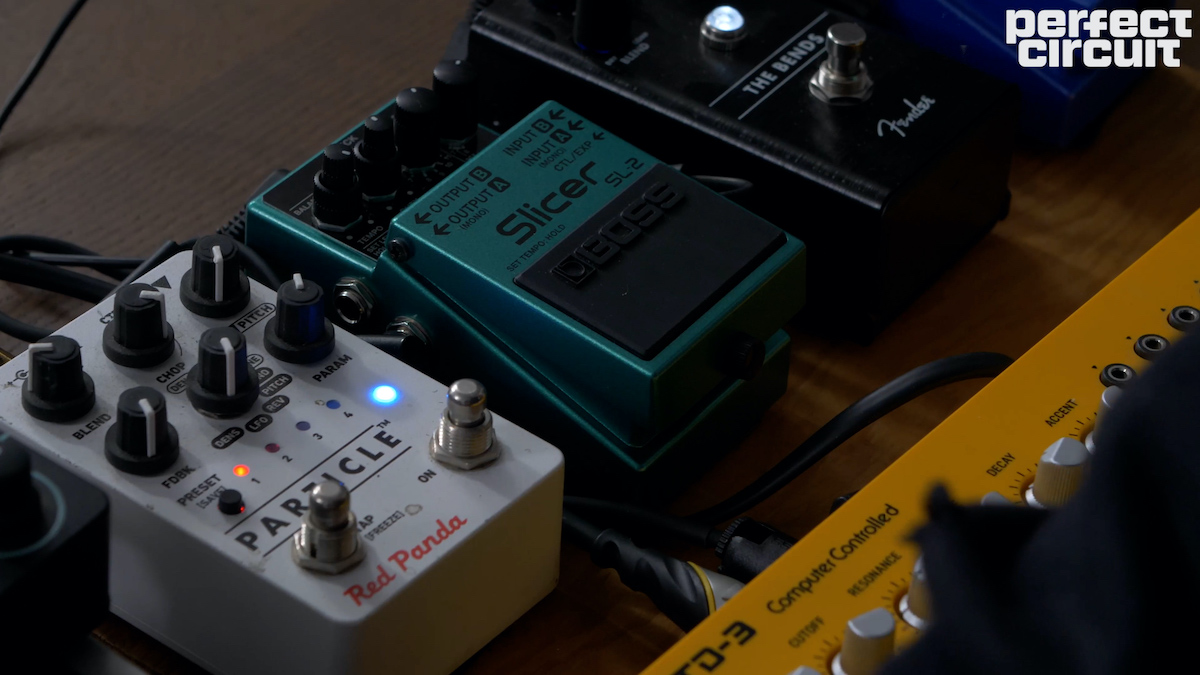
What even is a Slicer? The new Boss SL-2 Slicer is a unique rhythmic and sequencer-like effect, manipulating not only the amplitude of the sound passing through it but also applying additional effects to various "slices." Much like how Boss released the RE-2 compact Space Echo pedal earlier this year as a continuation of the iconic delay unit's legacy, the SL-2 is inspired by the original SL-20 Slicer pedal, which came out in 2008. But of course, this new one has a number of tricks up its sleeve, and addresses many limitations and missing features from the original.
Most notably, the new SL-2 is packed into the classic Boss compact pedal format, and somehow contains even more functionality than the original double-wide pedal. Up from the 50 patterns of the original, the SL-2 offers five different types of rhythmic effects split across eight pattern types with eleven variations each—that's 88 total Slicer patterns. There's single modes, dual modes, patterns with additional effects applied like phasers and flangers, and a whole lot of other sounds to discover. Additionally, the MIDI Input has been improved to not only accept MIDI Clock for tempo synchonization, but also CC messages for remote control.
Throwing the Slicer onto complex sounds and full mixes of instruments can lead to some really interesting and fun results. But to Nick's ears—and frankly, mine too—the Slicer isn't all that exciting when applied to a plain, dry guitar signal. The interesting variation in rhythms can make it a cool effect, but the sound of guitar and tremolo is so ingrained into the sonic language of rock and pop music that it's hard to entirely shake off cliche connotations. Maybe with the addition of a few other effects and instruments, it'd be possible to let the Slicer shine as a true powerhouse of rhythmic effects.
Slicer Supplements from Nick's Gear Collection
One way to get a feel for any pedal's usefulness is to try it out within different musical contexts. For example, using a Slicer as a soloist, as part of an ensemble, or as a full-mix processing tool will all yield totally different results. Because Nick came in by himself but didn't want to do a typical "guitar pedal demo" video, he opted to bring along a couple of electronic instruments to help him out.
Of course, Nick Reinhart has quite the collection of gear, with tons of stuff both old and new accumulated over the years. We would never force him to bring everything out to our studio, but we gladly welcomed anything that he felt would pair well with the Slicer for some fun jams. In this section of the article, we'll list out everything that was featured, before moving onto the next section and diving into how they were all combined in various ways.
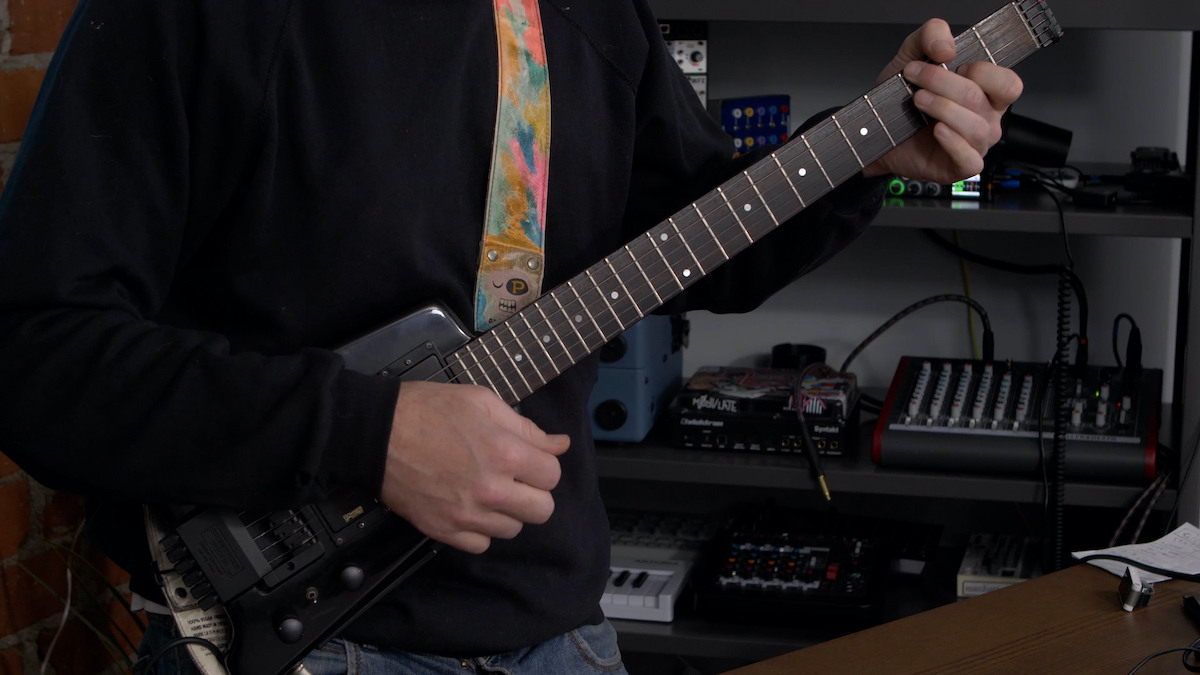
For the instruments being used, Nick brought along not only a guitar but also a couple of electronic pieces to round out his spontaneous ensemble. His axe of choice for our session was an old Hohner-branded Steinberger headless guitar for maximum "weird but lovable 80s music" vibes. Additionally, bass elements were supplied by a Behringer TD-3—yellow, of course—and drums came from an old Korg DDD-1. As a nice bonus, the DDD-1, TD-3, and Slicer can all be synced together via MIDI for shared tempo and timing. Sonically speaking, this trio of instruments harkens back to the sounds of the 1980s with ease, but we'll shake things up with some other pedals to offer some variety.
In addition to the SL-2, Nick brought another of his favorite recent Boss effects: the SY-1 guitar synthesizer pedal, perfect for giving that Steinberger a synthetic edge. For some other modern effect flavors, Nick brought in his trusty Red Panda Particle 2 and Meris Ottobit Jr. for granular, glitch, and general sound deconstruction duties. And finally, for utility purposes, Nick is also using an old Digitech HardWire DL-8 looper pedal, Fender's The Bends compressor, and a Red Panda Bit Mixer.

Putting the Band Together
Now that we've introduced every piece of gear, let's talk about how Nick combined them into a cohesive rig. The final setup could be considered analogous to a trio of guitar, bass, and drums with their own small signal chains. There's a number of different moving parts at play here, and it can be helpful to delegate various components to specific roles—all working together to reach some musical goal.

For the guitar rig, Nick is running the Steinberger into the DL-8 Looper first, then into the SY-1, The Bends, and finally the SL-2 Slicer. This might not be the pedal order that you'd initially expect to see, at least based on conventional pedalboard signal flow, but it actually makes a lot of functional sense. The compressor after the SY-1 keeps various synth modes consistent in volume, should Nick decide to flip through the different synth sounds. But most importantly, having the looper first means that any tweaks to pedals further down the chain will still have an audible effect, since it's only capturing the dry guitar signal. Additionally, as Nick mentions in the video, it serves as a bit of a timing safety net—even if he doesn't click his loop in perfect sync with the drums and bass synth, the Slicer will still chop it up "in time" down the line.
With the TD-3, Nick really wants it to just provide the gooey acid-like bass sounds that it excels at creating. But that said, a 303-style synth is an excellent platform for pedals, and he chose the Particle 2 to chew on his analog basslines. The Particle is a wild granular delay effect, capable of interesting smearing, chopping, glitching, reversing, and other effects outside of the typical norms of delay pedals. It's absolutely a fun pedal for tweaking and exploring, and fits in well among this collection of instruments and pedals.

As for the DDD-1, Nick doesn't want to totally obfuscate its lovably cheesy drum sounds with too many effects, but he does want to add a little bit of spice and magic. As an early drum machine from the 1980s, its performance features are certainly more limited than today's rhythmic powerhouses. With this in mind, Nick pairs the DDD-1 with the Ottobit Jr and its tempo-synced stutter effect to achieve little fills and glitches on otherwise static patterns. Of course, having its filter and sample/bit reduction can offer more sonic variety to the sounds of the DDD-1 as well.
But even though there's only one pedal being used as an effect on the drums, the DDD-1 serves another important purpose beyond simply providing percussion sounds. Like a human drummer could be seen as the central source of timing in an ensemble, Nick is using this drum machine as his MIDI clock source for both the TD-3 and SL-2. Clicking the start button on the DDD-1 will also start the TD-3's pattern playback, and sync up the Slicer's tempo to the beat. An interesting note here is Nick isn't actually using MIDI to sync the Ottobit's timing, but actually just using the manual tap tempo. Ottobit Jr.'s tap timing actually doesn't drift too far off of the tempo, and this method could also lead to some fun rhythms if you tapped in a subdivision like a triplet or dotted eight note.
Trying Out Ideas and Having Fun
As eloquently stated by Nick Reinhart at the video's conclusion, rules are meant to be broken when it comes to music and gear. The whole video is reminder to never lose the curious and exploratory side of your music making process, and realize how much fun you can have throwing different pieces together.
Whether you're like Nick and throwing a new pedal on some forgotten drum machine or trying out a new synth with your dusty old pedalboard from your days as a guitarist, leaning into old favorites and familiar tools is a great way to wrap your head around a shiny new piece of gear. And when you try putting things together in unexpected ways, that's where the true magic can happen.

